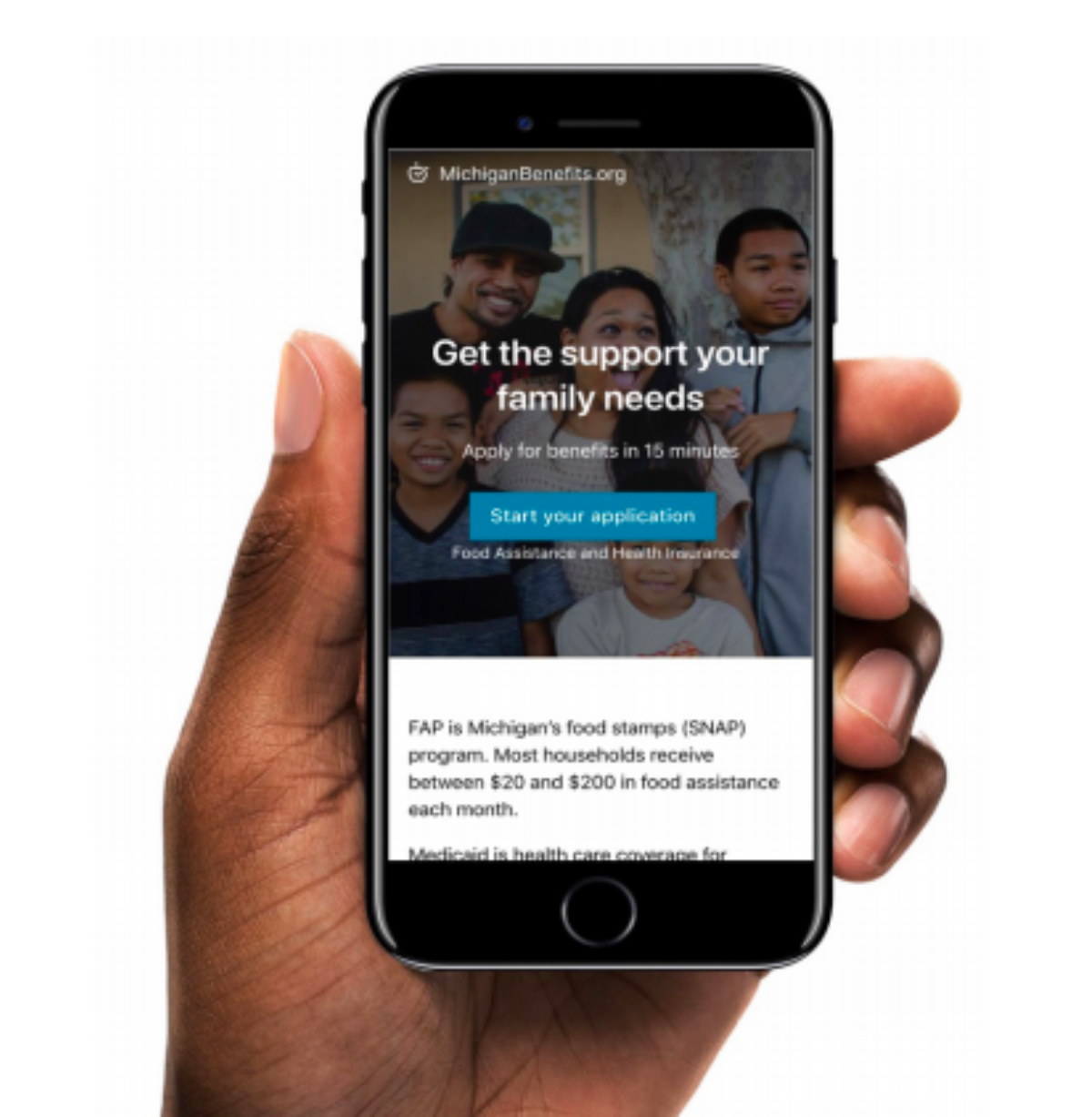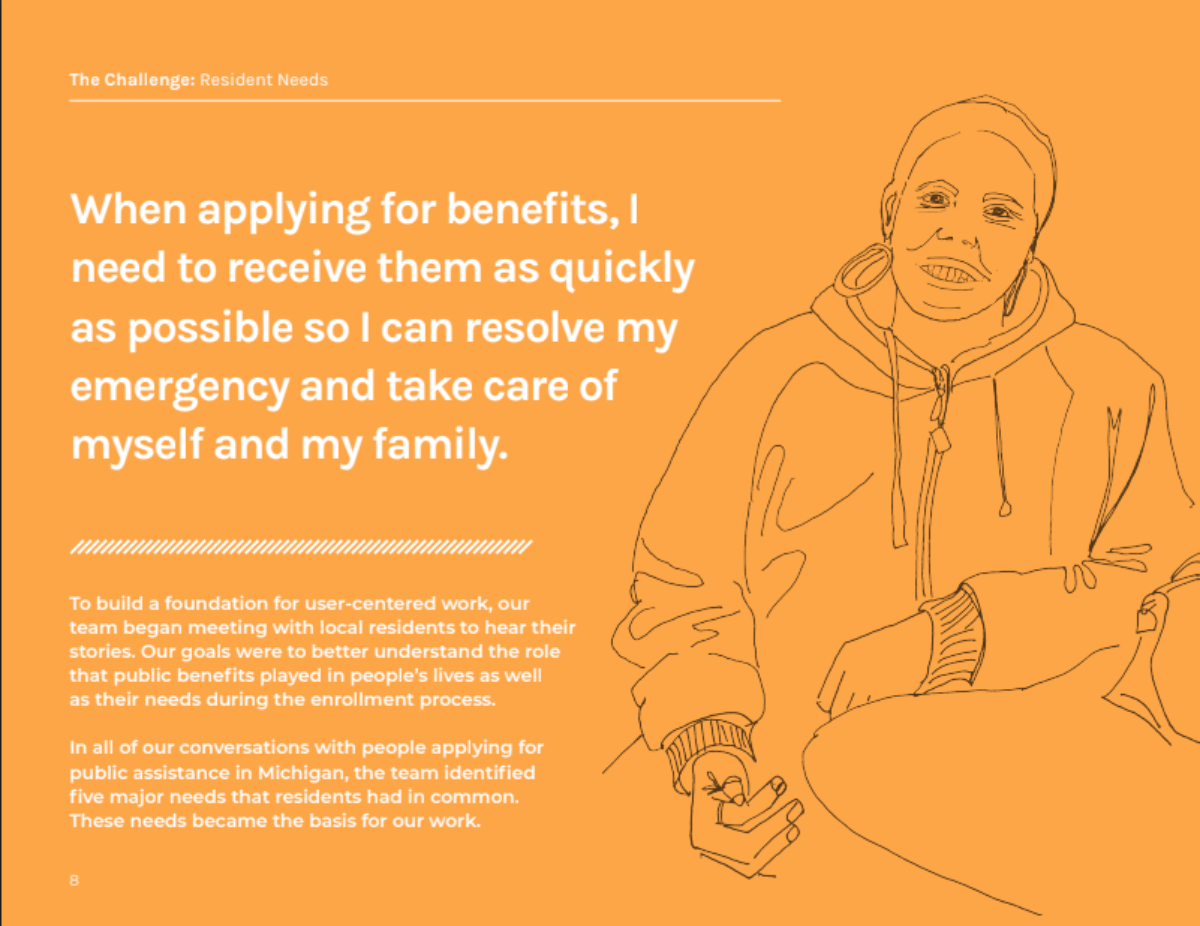- News and Stories
- Blog post
- Safety Net
Safety Net Services Built for Outcomes

At Code for America, we work to redesign safety net services to help people access the benefits they need. In this area, we’re mostly known for GetCalFresh, which guides Californians through the SNAP application process and helps government deliver food assistance to people in need. We’ve had such success growing GetCalFresh from a small pilot into what will be a statewide service starting in June, that last year we decided to expand this work to other states and other benefits with the Integrated Benefits Initiative.* We recently concluded our first pilot in Michigan, where our work to integrate benefits proved that a human-centered safety net is possible, and we’re excited to share out those results.
In Michigan, we worked specifically on ways to deliver faster benefits eligibility determinations to the people who need them. For this pilot we partnered with Civilla, a Detroit-based non-profit dedicated to improving public services through human-centered design. Together, we were able to bring the learnings of Code for America’s years of work on GetCalFresh and pair them with Civilla’s deep insights and on-the-ground relationship with the Michigan Department of Health and Human Services (MDHHS) to improve outcomes for Michigan residents.
Designing for human needs
When you hear the term “user-centered design” in the tech world, your mind will usually (and rightfully) go to the end-user of the product. So if we’re streamlining access to benefits, we should obviously be designing for the person who’s filling out the application, who’s usually referred to as the “client.” But that’s not the only user we’re considering. The Integrated Benefits Initiative is also working to design and build for all users in the benefits delivery system, and to consider the relationships between them. In this case, that included MDHHS caseworkers.
How to design for the needs of both sets of users? First, Civilla and Code for America conducted deep user research to understand pain points for clients and caseworkers throughout the entire application process. While each person’s experience was unique, we were able to identify key themes around both user and caseworker experience. Within those themes, we determined concrete needs for each user that we could work to address directly, such as a quick and reliable way for clients to ask questions during the application process, or comprehensive proof of financial eligibility for caseworkers.


We ended up deciding to create two pilots: a digital assister (an expanded and redeployed version of GetCalFresh) and a two-way text messaging service. Building on technology modernization efforts that are already underway in Michigan, we took an approach that the private sector has successfully applied to building easy-to-use products to address real human needs: user-centered, agile, and mobile first.


A pilot built for outcomes
Michigan was our first opportunity to test the hypothesis of the Integrated Benefits Initiative on the ground, and we worked hard to create a faster, easier, mobile-friendly experience for clients that would simultaneously deliver clear and complete information to caseworkers. We’re thrilled to report that by the end of the pilot, we saw measurable improvements in client success rates along key metrics.

At the close of the nine-month digital assister pilot, we saw a drastically reduced median time that it takes for clients to complete an application, a reduction in the number of days it took MDHHS to determine whether the client is eligible for benefits, and, most importantly, a steep increase in the percentage of people who were approved for health and food assistance benefits.
Our two-way text messaging pilot between clients and caseworkers to assist in document submission — the first of its kind in the country — was a shorter two-month pilot. We did see improved outcomes in both the length of time to eligibility determination and overall approval rates. However, the percentage of denials due to missing verification documents stayed essentially the same.

But beyond these great results: we saw a potential for much larger design impact in the way that our county-level pilot influenced a statewide technology. Our pilots occurred at the time that MDHHS was working to redesign MI Bridges, the portal that Michigan residents throughout the state use to access services like food assistance and healthcare. MDHHS was able to take learnings and best practices from our digital assister and implement them to improve the state’s new online application. These improvements included streamlining organization and flow, redesigning navigation to incorporate visual progress bars, and simplifying copy to make it easier to understand. MI Bridges is accessed by more than 75,000 people per month — and it’s incorporating user-centered design principles and practices that were proven effective in the pilot.
What comes next
In August, we wrote that we had selected Integrated Benefits pilot sites for each state’s “commitment to innovation — to experiment with new technology and methods, and to work together to consider and prioritize the client experience within their eligibility and enrollment processes.” At the conclusion of our first of these four pilots, we’re proud to say that our partnership with the state of Michigan delivered on all of these fronts and produced notably improved outcomes for Michigan residents. We’re proving that a human-centered safety net is possible, and that it’s possible to work with government in agile, iterative ways. We’ve already shared early findings of this in our work with our next pilot site, Colorado, and you can expect to hear more about it as that pilot wraps up.
We could not have done this work without our partners at the Michigan Department of Health and Human Services. We particularly want to thank the staff at the Clio Road and Union Street field offices in Flint for their enthusiasm, their patience with us, and their willingness to try some new things. Their dedication to the work and to the people of Flint is truly remarkable, and it was an honor to work with them on this pilot.
The work in Michigan was our first proof point that user-centered, agile development leads to better government services. We might not be able to create a human-centered safety net overnight, but we will keep sharing concrete examples of the building blocks to get it done.
Want to dive deep into the details? Read our full report: Streamlining Access to Public Benefits in Michigan
*In 2016 the Center for Medicare and Medicaid Services (CMS) and the United States Digital Service (USDS) partnered to use human-centered design and modern technology in improving how applicants get access to Medicaid and other services. Inspired by the work of Code for America in California (GetCalFresh.org), Civilla in Michigan (Project Re:Form) and a number of other initiatives around the country, the USDS team convened a small network of practitioners dedicated to improving the delivery of critical safety net services broadly. At the close of the Obama Administration, the community they seeded grew into the partnership we now call the Integrated Benefits Initiative.